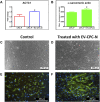Human Cardiac Progenitor Cell-Derived Extracellular Vesicles Exhibit Promising Potential for Supporting Cardiac Repair in Vitro
- PMID: 35669580
- PMCID: PMC9163838
- DOI: 10.3389/fphys.2022.879046
Human Cardiac Progenitor Cell-Derived Extracellular Vesicles Exhibit Promising Potential for Supporting Cardiac Repair in Vitro
Abstract
Although human Cardiac Progenitor Cells (hCPCs) are not retained by host myocardium they still improve cardiac function when injected into ischemic heart. Emerging evidence supports the hypothesis that hCPC beneficial effects are induced by paracrine action on resident cells. Extracellular vesicles (EVs) are an intriguing mechanism of cell communication based on the transport and transfer of peptides, lipids, and nucleic acids that have the potential to modulate signaling pathways, cell growth, migration, and proliferation of recipient cells. We hypothesize that EVs are involved in the paracrine effects elicited by hCPCs and held accountable for the response of the infarcted myocardium to hCPC-based cell therapy. To test this theory, we collected EVs released by hCPCs isolated from healthy myocardium and evaluated the effects they elicited when administered to resident hCPC and cardiac fibroblasts (CFs) isolated from patients with post-ischemic end-stage heart failure. Evidence emerging from our study indicated that hCPC-derived EVs impacted upon proliferation and survival of hCPCs residing in the ischemic heart and regulated the synthesis and deposition of extracellular-matrix by CFs. These findings suggest that beneficial effects exerted by hCPC injection are, at least to some extent, ascribable to the delivery of signals conveyed by EVs.
Keywords: cardiac regenerative medicine; extracellular vesicles; human cardiac fibroblasts; human cardiac progenitor cells; paracrine effects.
Copyright © 2022 Romano, Belviso, Sacco, Cozzolino, Nurzynska, Amarelli, Maiello, Sirico, Di Meglio and Castaldo.
Conflict of interest statement
The authors declare that the research was conducted in the absence of any commercial or financial relationships that could be construed as a potential conflict of interest.
Figures








Similar articles
-
P2Y2 Nucleotide Receptor Prompts Human Cardiac Progenitor Cell Activation by Modulating Hippo Signaling.Circ Res. 2017 Nov 10;121(11):1224-1236. doi: 10.1161/CIRCRESAHA.117.310812. Epub 2017 Sep 18. Circ Res. 2017. PMID: 28923792 Free PMC article.
-
Extracellular Vesicles Released by Allogeneic Human Cardiac Stem/Progenitor Cells as Part of Their Therapeutic Benefit.Stem Cells Transl Med. 2019 Sep;8(9):911-924. doi: 10.1002/sctm.18-0256. Epub 2019 Mar 28. Stem Cells Transl Med. 2019. PMID: 30924311 Free PMC article.
-
Empowering human cardiac progenitor cells by P2Y14 nucleotide receptor overexpression.J Physiol. 2017 Dec 1;595(23):7135-7148. doi: 10.1113/JP274980. Epub 2017 Nov 9. J Physiol. 2017. PMID: 28980705 Free PMC article.
-
Emerging roles of extracellular vesicles in cardiac repair and rejuvenation.Am J Physiol Heart Circ Physiol. 2018 Oct 1;315(4):H733-H744. doi: 10.1152/ajpheart.00100.2018. Epub 2018 Jun 27. Am J Physiol Heart Circ Physiol. 2018. PMID: 29949381 Review.
-
Control of autocrine and paracrine myocardial signals: an emerging therapeutic strategy in heart failure.Heart Fail Rev. 2010 Nov;15(6):531-42. doi: 10.1007/s10741-010-9165-7. Heart Fail Rev. 2010. PMID: 20364318 Review.
Cited by
-
Therapeutic potential of urinary extracellular vesicles in delivering functional proteins and modulating gene expression for genetic kidney disease.Biomaterials. 2025 Oct;321:123296. doi: 10.1016/j.biomaterials.2025.123296. Epub 2025 Mar 26. Biomaterials. 2025. PMID: 40158444
-
Decellularized Extracellular Matrix for Modeling Cardiac Extracellular Microenvironment.Methods Mol Biol. 2024;2803:3-12. doi: 10.1007/978-1-0716-3846-0_1. Methods Mol Biol. 2024. PMID: 38676881
References
-
- Barile L., Lionetti V., Cervio E., Matteucci M., Gherghiceanu M., Popescu L. M., et al. (2014). Extracellular Vesicles from Human Cardiac Progenitor Cells Inhibit Cardiomyocyte Apoptosis and Improve Cardiac Function after Myocardial Infarction. Cardiovasc. Res. 103, 530–541. 10.1093/cvr/cvu167 - DOI - PubMed
LinkOut - more resources
Full Text Sources

